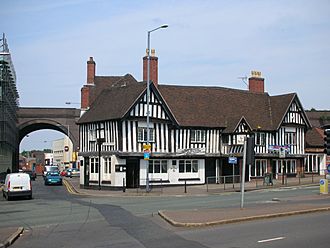The Old Crown, Birmingham facts for kids
Quick facts for kids The Old Crown |
|
|---|---|
 |
|
| General information | |
| Architectural style | Black and white timber frame |
| Town or city | Birmingham |
| Country | England |
| Coordinates | 52°28′29″N 1°53′01″W / 52.4747°N 1.8836°W |
| Completed | 1450-1500 |
The Old Crown is a famous pub in Deritend, a part of Birmingham, England. It's known for being one of the oldest buildings in the city that isn't a church. This amazing building is officially protected as a Grade II* listed site. It looks very old with its "black and white" timber frame style. While some people think it dates back to around 1368, most of the building you see today was built in the early 1500s.
Contents
A Look Back in Time: The Old Crown's Story
How Old Is It Really?
Experts believe The Old Crown was built between 1450 and 1500. There's even some proof suggesting it was finished in 1492. That's the same year Christopher Columbus sailed to America! A writer named John Leland saw the building in 1538 and described it as a "mansion house of tymber."
It's thought that The Old Crown was originally built as the Guildhall and School of St John, Deritend. A "guild" was like a club for people with the same job, and a "guildhall" was their meeting place. This guild owned other buildings too.
From Guildhall to Inn
In 1589, a man named John Dyckson bought the building. He was known as a "Caryer," which meant he transported goods using packhorses. Imagine a long line of horses carrying bags and boxes! He would have needed stables for his horses and a place to store goods.
These features were also very useful for other travelers. This is probably when The Old Crown started being used as an Inn, a place where travelers could stay. England was very proud after defeating the Spanish Armada the year before, so naming it 'the Crown' would have been popular. The first official record of it being an inn is from 1626. It was called "the Crowne" by 1666.
Battles and Changes
During the English Civil War, some exciting battles happened around The Old Crown. Prince Rupert's soldiers raided Birmingham, and there were fights right near the building!
Later, the building was changed. In 1684, it was split into two houses, and then into three houses in 1693. It stayed as three separate homes until the 1800s.
In 1851, a man named Joshua Toulmin Smith became a hero for The Old Crown. The local council, called "the Corporation," wanted to knock it down to make the street better. But Smith fought to save it! He saved it again in 1856 and 1862, making sure this historic building stayed standing.
The Old Crown Today
In 1991, a local pub company, owned by the Brennan family, bought The Old Crown. In 1994, Pat Brennan and his son Peter were fixing up the back of the property. They made an amazing discovery: an old well that had been hidden for over 100 years! It's now restored and you can see it at the back entrance of the pub.
In 1998, the Brennan family spent a lot of money to restore The Old Crown to its original glory. Thanks to their hard work, this famous old building is still a popular pub today.
How It Was Built
The Old Crown is quite large! On the ground floor, it's about 71 feet (21.6 meters) wide and 20 feet (6.1 meters) deep. The first floor hangs over the front and is a bit deeper, at 21 feet 9 inches (6.6 meters).
When it was first built, the main hall inside was about 40 feet (12.2 meters) long and 20 feet (6.1 meters) wide. Below this, there were several arched cellars. On the upper floor, there were only four rooms.
Behind the building, there was a courtyard with a well. This well was originally about 26 feet (7.9 meters) deep. It was later dug deeper to a total of 38 feet (11.6 meters). The new part of the well was lined with square bricks. At the top, it was about 2 feet 7 inches (79 cm) wide at its narrowest and 2 feet 9 inches (84 cm) at its widest. It got wider towards the bottom, reaching about 4 feet (1.2 meters) across. In 1863, the well was cleaned, and Joshua Toulmin Smith added an iron gate to protect it while still letting people see it.

